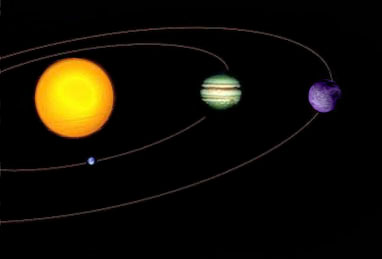Trojan Asteroids
The points L1, L2 and L3 lie on a straight line connecting the other two
bodies (Fig. 1) and are points of unstable equilibrium.
This means that a small perturbation will cause the third body to drift away.
The L4 and L5 points are at the third vertex of an equilateral
triangle (Sun-Jupiter - L4 or L5) formed with the other two bodies; they are points of stable equilibrium.
Objects orbiting around L4 and L5 are stable because the Coriolis force keeps them spinning
around the Lagrange point.
For a long time it was believed that the Lagrange's solutions of the restricted problem are only
of theoretical interest.
But one century later, in February 1906 Max Wolf (1863-1932) discovered the first Trojan asteroid and named it Achilles (588) after the mythical Achilles, one of
the heroes of Homer's Iliad. As of October 1999, 170 had been numbered. By July 2004 that number had grown to 877.
As the Iliad deals with the events of the Trojan War, the asteroids came to be
collectively known as Trojan asteroids or Trojan cloud. Strictly speaking, the term Trojan applies
only to those in the L4 and L5 points of the Sun-Jupiter system, but
over time, it has come to be more generally applied to any planetoidal
body at the triangular Lagrangian point of any more massive two bodies. Besides Jupiters
Trojans, Mars and Neptune have one Trojan each, plus there are Trojan moons around Saturn
(Telesto-Thetys-Calypso and Dione-Helene). The moon Helene orbits in Dione's
leading Lagrangian point. Calypso is co-orbital with the moon Tethys,
and resides in Thety's trailing Lagrangian point L5. The moon Telesto resides in Thetys
leading point.
Also some Mars Trojans were found, but they could not be confirmed.
Now a few comments of the Minor-planet-center (=MPC) to the confirmation of the Mars Trojans and the
number of the other ones are at
MPC.
Earth Trojans have not been found yet, but these objects could someday be of great practical value,
though. After the Moon, they would be easily 'accessible objects' in term of the energy
required to reach them. The energy required to return materials from an Earth-Trojan
orbit to the Earth is much smaller than for the other minor planets in the solar system.
Back
|
















